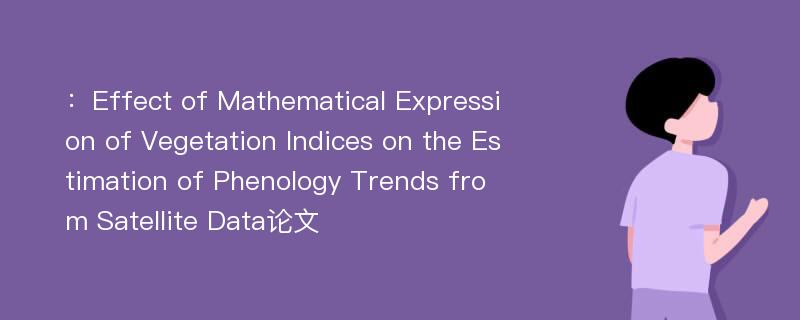
本文主要研究内容
作者(2019)在《Effect of Mathematical Expression of Vegetation Indices on the Estimation of Phenology Trends from Satellite Data》一文中研究指出:Vegetation indices(VIs) from satellite remote sensing have been extensively applied to analyze the trends of vegetation phenology. In this paper, the NDVI(normalized difference vegetation index) and SR(simple ration), which are calculated from the same spectral bands of MODIS data with different mathematical expressions, were used to extract the start date(SOS) and end date(EOS) of the growing season in northern China and Mongolia from 2000 to 2015. The results show that different vegetation indices would lead to differences in vegetation phenology especially in their trends. The mean SOS from NDVI is 15.5 d earlier than that from SR, and the mean EOS from NDVI is 13.4 d later than that from SR. It should be noted that 16.3% of SOS and 17.2% of EOS derived from NDVI and SR exhibit opposite trends. The phenology dates and trends from NDVI are also inconsistent with those of SR among various vegetation types. These differences based on different mathematical expressions in NDVI and SR result from different resistances to noise and sensitivities to spectral signal at different stage of growing season. NDVI is prone to be effected more by low noise and is less sensitive to dense vegetation. While SR is affected more by high noise and is less sensitive to sparse vegetation. Therefore, vegetation indices are one of the uncertainty sources of remote sensing-based phenology, and appropriate indices should be used to detect vegetation phenology for different growth stages and estimate phenology trends.
Abstract
Vegetation indices(VIs) from satellite remote sensing have been extensively applied to analyze the trends of vegetation phenology. In this paper, the NDVI(normalized difference vegetation index) and SR(simple ration), which are calculated from the same spectral bands of MODIS data with different mathematical expressions, were used to extract the start date(SOS) and end date(EOS) of the growing season in northern China and Mongolia from 2000 to 2015. The results show that different vegetation indices would lead to differences in vegetation phenology especially in their trends. The mean SOS from NDVI is 15.5 d earlier than that from SR, and the mean EOS from NDVI is 13.4 d later than that from SR. It should be noted that 16.3% of SOS and 17.2% of EOS derived from NDVI and SR exhibit opposite trends. The phenology dates and trends from NDVI are also inconsistent with those of SR among various vegetation types. These differences based on different mathematical expressions in NDVI and SR result from different resistances to noise and sensitivities to spectral signal at different stage of growing season. NDVI is prone to be effected more by low noise and is less sensitive to dense vegetation. While SR is affected more by high noise and is less sensitive to sparse vegetation. Therefore, vegetation indices are one of the uncertainty sources of remote sensing-based phenology, and appropriate indices should be used to detect vegetation phenology for different growth stages and estimate phenology trends.
论文参考文献
论文详细介绍
论文作者分别是来自Chinese Geographical Science的,发表于刊物Chinese Geographical Science2019年05期论文,是一篇关于,Chinese Geographical Science2019年05期论文的文章。本文可供学术参考使用,各位学者可以免费参考阅读下载,文章观点不代表本站观点,资料来自Chinese Geographical Science2019年05期论文网站,若本站收录的文献无意侵犯了您的著作版权,请联系我们删除。
